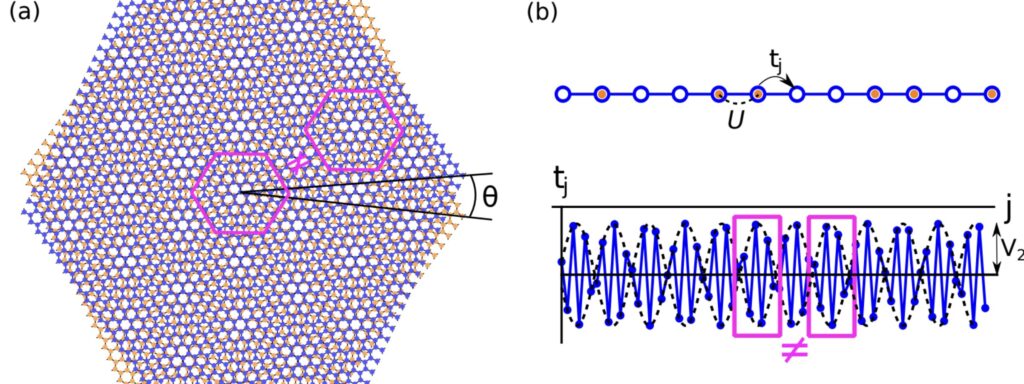Moiré materials, such as twisted bilayer graphene, are materials generally formed by stacking two or more layers of 2D materials on top of each other with a small lattice mismatch. This slight mismatch creates a unique pattern known as the moiré pattern, which is associated with desirable optical and electronic properties.
Researchers at Universidade de Lisboa, Universidade do Porto and Universidade do Minho carried out a study investigating how the quasiperiodicity of one-dimensional (1D) narrow-band moiré systems impacts their properties.
Their findings, published in Nature Physics, demonstrate that the ground-state properties of these materials are altered in a fundamental way by quasiperiodicity.
“Our work was motivated by a rather ambitious question we want to answer regarding moiré materials,” Miguel Gonçalves, first author of the paper, told Phys.org.
“These materials have captivated exceptional attention in the condensed matter physics community during the past six years due to the remarkable experimental observations of exotic phases of matter, such as superconductivity and other correlated phases, where electron-electron interactions play a crucial role.”
The distinctive pattern of moiré systems is produced by the interference between slightly mismatched crystalline layers. Notably, this pattern can be tuned by changing the twist angle between different stacked layers.
“If we zoom out, the moiré pattern appears to repeat itself, being periodic,” said Gonçalves. “However, this repetition is only exact for fine-tuned (commensurate) twist angles. For generic angles, when we zoom in to the atomic scale, we see that while the moiré pattern ‘almost’ repeats in space, it never exactly does so, forming a so-called quasiperiodic spatial profile, where each of the moiré ‘unit cells’ is slightly different from any other cell.”
Past theoretical studies have studied moiré systems in great depth. Nonetheless, most of these studies assume that these systems exhibit periodicity (i.e., that atoms in their lattice are arranged in a repeating or regular pattern).
“This assumption simplifies the problem and allows for the accurate description of a big part of the experimental observations,” explained Gonçalves.
“Paradoxically, it has long been known that quasiperiodicity can profoundly modify the properties of the system’s quantum wave function. With this in mind, our central questions were whether the interplay between quasiperiodicity and electron-electron interactions could lead to new states of matter not attainable in periodic systems and whether the effect of interactions can be enhanced by quasiperiodicity.”
Accurately describing the interactions between pairs of electrons in materials has been a long-standing challenge for physicists and to this date there is no general tool to achieve this. Including quasiperiodicity in this equation further complicates the task, as it prevents researchers from exploiting the translational symmetry of materials.

“In 1D, however, we have a powerful tool—known as the density-matrix-renormalization-group method—that allows us to treat electron-electron interactions exactly and simulate sufficiently large systems to study the effect of quasiperiodicity,” said Gonçalves.
“To take the first step towards answering our ambitious question, we studied the ground-state phase diagram of a 1D chain of atoms, where electrons can tunnel from neighboring atoms with a hopping amplitude that is modulated quasiperiodically.”
Discover the latest in science, tech, and space with over 100,000 subscribers who rely on Phys.org for daily insights.
Sign up for our free newsletter and get updates on breakthroughs,
innovations, and research that matter—daily or weekly.
The model system studied by Gonçalves and his colleagues contains various key ingredients that are also present in 2D moiré systems. These include a moiré pattern, a narrow energy band and quasiperiodicity.
While the researchers’ model system is one-dimensional, it can potentially be realized in laboratory experiments with ultracold atoms and trapped findings. These experiments could help to verify the team’s new findings.
“Our most notable finding was that quasiperiodicity can enhance the effect of interactions and the interplay between these ingredients can indeed give rise to new states of matter that cannot be realized in similar, but otherwise periodic, systems,” said Gonçalves.
“In particular, we carried out a detailed comparison of the phase diagrams in the plane of interaction and hopping strengths for quasiperiodic and periodic systems, where in the latter the hopping modulation was chosen to be exactly periodic.”
Interestingly, Gonçalves and his colleagues observed that the phase diagrams they examined became drastically different when the hopping strength exceeded a critical value. Above this critical value and in the absence of interactions, the 1D quasiperiodic moiré system enters a multifractal exotic phase that cannot be reached in a corresponding periodic system.
“More concretely, our crucial novel finding was that when interactions are turned on within this phase in the quasiperiodic system, a new regime—that we have termed ‘quasi-fractal charge density wave’—is stabilized,” said Gonçalves.
“In this regime, the ground-state wave function exhibits charge order modulation with a remarkably large number of wave vectors. In the periodic case, on the other hand, no charge-order is observed at all, in this same region of the phase diagram.”
The recent paper by this team of researchers hints at the existence of a new state of matter in an 1D quasiperiodic narrow-band moiré system. This development could pave the way for further studies focusing on interacting quasiperiodic systems, potentially leading to the discovery of new exotic states.
“We are now developing techniques to investigate the interplay between quasiperiodicity and interactions beyond one dimension,” added Gonçalves.
“We are particularly interested in exploring two-dimensional moiré materials, where we believe that the combination of these ingredients can lead to an even richer set of possibilities waiting to be uncovered and added to the already remarkable repertoire of these materials.”


